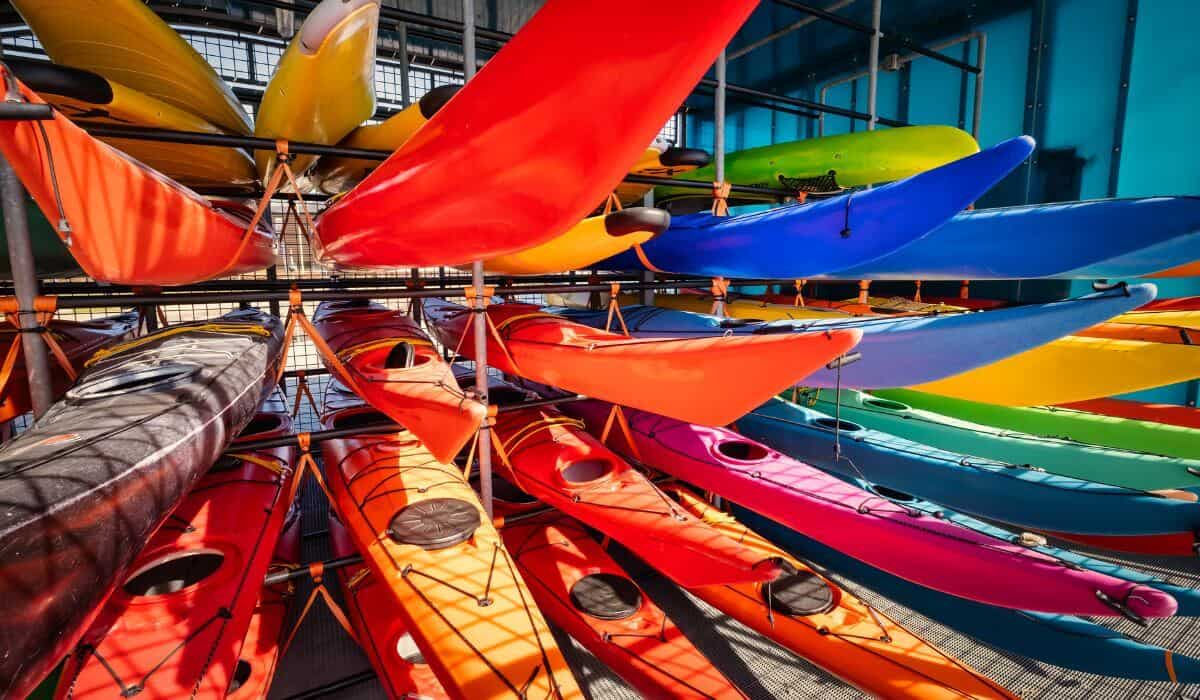Best Kayak Storage Solutions (2023)
Proper Kayak storage is essential for maintaining the quality and longevity of your kayak. When storing your kayak, whether it’s outdoors or indoors, there is a range of options to safeguard your boat. In this blog post, we’ll explore different types of outdoor kayak storage such as racks and covers, as well as indoor kayak storage solutions like hoists and suspension systems.
We’ll also discuss the benefits of storing your kayak inside versus outside, how to properly store inflatable kayaks, and what factors to consider when choosing a long-term storage unit. By the conclusion of this article, you’ll have all the knowledge needed to store your kayak securely and confidently in any setting.
Table of Contents
Identifying the Best Kayak Storage Solutions

Storing your kayak is an important part of the outdoor adventure experience. To ensure your kayak is safe and secure for years to come, here are some tips to consider when selecting the best kayak storage solution.
When storing a kayak inside, make sure you have enough space in the room or garage where you plan to store it. If you don’t have enough space, consider investing in a storage unit specifically designed for kayaks such as racks and wall-mounted systems. You should also consider how long-term kayak storage may affect the condition of your kayak’s hull if stored flat on its side or upside down on cushions or other materials that can cause dents over time.
For outdoor kayak storage, opt for an area with good drainage and shielding from direct sunlight, gusts of wind, rain, and snow. Consider using covers made out of waterproof material such as canvas or vinyl which will help protect against UV damage while keeping moisture out too. Make sure any straps used to hold the cover in place are strong enough so they won’t break under pressure when exposed to harsh weather conditions like heavy winds and rain storms.
For inflatable kayaks, special care should be taken when storing them both indoors and outdoors due to their delicate nature compared with hardshell models – particularly those made out of PVC fabric which can easily become damaged if placed on an uneven surface without proper padding underneath. To make sure these boats are kept safe from harm try using hoists suspended above the ground level (like tree branches) with suspension cords attached at either end along with cushioning between each section so they won’t rub against one another leading to wear over time; this will also save space.
Finally, remember that saltwater environments require extra caution when choosing how and where you are going to store your kayak since prolonged exposure can corrode metal parts quickly. Therefore, always opt for freshwater storage locations whenever possible, even if it means sacrificing convenience temporarily until better options become available later down the line.
Properly identifying the best kayak storage solutions is essential for protecting your investment and keeping it in top condition. To ensure you’re taking all necessary steps to properly store your kayak, read on to learn how to prepare it before storing away.
The Key Takeaway: Kayak storage solutions vary depending on whether you’re storing indoors or outdoors, but all options should provide adequate protection from the elements. For inflatable boats, hoists and suspension cords with cushioning between each section are a great way to protect them while saving space too – just remember to be extra cautious when dealing with saltwater environments as prolonged exposure can corrode metal parts quickly.
Preparing Your Kayak for Storage

It’s essential to take the time to properly prepare your kayak for storage, so you can get back out on the water with minimal effort when the weather turns warmer. Here are some key steps to consider when preparing your kayak for storage:
Clean Your Kayak:
Before storing away a used kayak, make sure it’s clean inside and out. Use warm soapy water or a specialized cleaner like 303 Protectant Spray Cleaner, then rinse off with fresh water and dry thoroughly before stowing away in kayak storage.
Secure Any Accessories:
Make sure any accessories such as paddles or life jackets are secured in place by tying them down using bungee cords or straps before putting them into kayak storage. This will help ensure they stay secure during transport and won’t cause damage while stored away in between uses.
Check All Hardware & Seals:
Check all hardware and seals on your kayak for signs of wear and tear before storing it away. If there’s any damage, replace parts as needed so that everything is functioning correctly come springtime.
Inspect Hull & Seams For Damage:
Inspect the hull of your boat for cracks or other damage that may have occurred over time from use in saltwater environments or general wear-and-tear from being transported regularly. If there’s anything suspicious, have a professional inspect further before proceeding with repairs if necessary – this could save you money down the line.
Click here to read our article on DIY Kayak Repair
Store your kayaks indoors if possible; otherwise, find a dry spot outside where they will be protected from direct sunlight as UV rays can cause fading. Consider adding an extra layer of protection against moisture build-up by covering boats with tarpaulin covers during long periods of non-use too.
Properly preparing your kayak storage will ensure that it remains in good condition and is ready to use when you are. Weighing up the advantages and disadvantages of keeping a kayak inside or out can be tough, but considering both sides carefully can help you pick what works best for you.
The Key Takeaway: Before storing a previously used kayak, give attention to examining and washing all components and seals for indications of damage. Additionally, secure any accessories such as paddles or life jackets with bungee cords before stowing them away in kayak storage, while also ensuring that your kayak is stored indoors if possible or covered with tarpaulin covers outside when not in use.
Storing Your Kayak Indoors vs Outdoors

Storing your kayak can be done either inside or outside; each has its advantages and disadvantages to think about before deciding. Storing your kayak either indoors or outdoors has its advantages and disadvantages to think about before settling on a choice.
Indoor storage offers the most protection for your kayak, as long as you’re storing it in an area with no moisture or extreme temperatures. It also allows for easy access when needed and can save space if you’re not using the entire room for storage. On the downside, indoor storage requires more maintenance than outdoor storage because of dust accumulation and potential pest infestations. Moreover, some kayaks may be too bulky to fit comfortably in a home without occupying an excessive area.
For those who need quick access to their boats but lack the space for long-term indoor storage, outdoor racks can be a great solution. Regular maintenance is essential, however; wind-driven sand particles and sea spray could cause rusting and corrosion if left unchecked. To prevent sagging while suspended off ground level, suspension cords/systems should be installed on either side of the boat’s carrying handles, and covers made specifically for this purpose should also be used.
Storing your kayak indoors or outdoors will depend on the size of your boat, available space, and climate. Preserving the kayak during storage is critical for keeping it in excellent shape for a long time.
The Idea: For outdoor adventurers, kayak storage can be a tricky task. When deciding on kayak storage, you should consider both indoor and outdoor options as each has its advantages and disadvantages. Outdoor racks are great for those with limited space but need regular maintenance to protect against rusting and corrosion caused by wind-driven sand particles and sea spray.
Maintaining Your Kayak During Storage

Storing your kayak properly is essential for its longevity and safety. Whether you’re storing it indoors or outdoors, there are several things to consider before putting it away. Here are some tips on how to maintain your kayak during storage:
When picking a spot to keep your kayak, ensure that the area is dry and doesn’t contain any possible dangers like water damage, critters, or debris. If you’re storing it outside, choose a spot with adequate shade and cover from rain or snow. For indoor storage, an area with enough room for the kayak and other items such as paddles and life jackets should be considered.
Secure Your Kayak Properly:
Once you have chosen a suitable location for your kayak’s storage space, secure it in place using racks or straps designed specifically for this purpose. This will ensure that your boat stays upright while also preventing accidental movement when transporting it around town or on trips away from home. To further protect your kayak, try to maintain its hull in a flat position rather than suspending it on something.
Cover Your Kayak:
Investing in a good quality cover is important when keeping your kayaks stored safely indoors or out to protect them from dust particles settling into their surfaces as well as UV rays which can cause fading over time. There are many different types available depending upon what type of material they are made out of (canvas vs plastic) so take some time researching which one would best suit both your needs and budget accordingly.
If you own an inflatable kayak, make sure to tightly shut all valves after each use to prevent air leakage during extended storage periods in heated environments like garages or sheds where temperatures can fluctuate significantly more than outdoors. To further protect your vessel from wear and tear, experts recommend investing in suspension cords/systems which evenly distribute weight across its length, thus reducing strain on weak spots over time.
The Idea: When storing your kayak, make sure to choose the right space that is free from potential hazards and secure it properly using racks or straps. Invest in a good quality cover and consider suspension cordssystems for inflatable kayaks to ensure their longevity over time.
FAQs about Kayak Storage
How should kayaks be stored?
For optimal preservation, kayaks should be sheltered from direct sunlight and extreme temperatures in a dry environment. It’s important to keep the kayak out of standing water or moisture as this can cause damage to the hull over time.
When storing for long periods, it’s best to store your kayak upside down on racks designed specifically for them, with adequate support beneath the hull so no part of it touches the ground.
If possible, use straps or covers to protect against dust and dirt build-up. Lastly, check all parts periodically for wear and tear before taking your kayak out on any adventures.
Is storing kayaks outside bad?
Storing kayaks outside can be detrimental to the lifespan of your boat. Exposure to varying temperatures, sunlight, and humidity can accelerate the deterioration of the kayak’s material.
Kayaks should ideally be stored in a garage or shed away from direct sunlight and other harsh weather conditions. If storing outdoors is unavoidable, cover it with a tarp for protection against sun damage and moisture buildup.
Regularly check for signs of wear and tear such as fading colors or cracking materials so that you can take action before more serious damage occurs.
Should kayaks be stored inside or outside?
It is not advisable to leave kayaks outside, as it can cause harm to the vessel from varying weather conditions. Sunlight and heat can weaken the hull material over time, while moisture and cold temperatures can cause cracking or warping of the plastic.
When not in use, kayaks should be placed somewhere cool and dry that is free from direct sunlight. If storing outdoors is unavoidable, cover your kayak with a waterproof tarp or other protective covering that will keep out sun, rain, snow, and dirt.
Is it OK to store a kayak vertically?
Vertically storing a kayak is not suggested, as it can put undue tension on the hull and cause unnecessary strain to the material. Additionally, storing a kayak in this manner may leave it vulnerable to damage from weather or other elements.
It is best to store your kayak horizontally with proper support underneath its length so that weight is evenly distributed along its entire surface area. Doing so will help ensure your vessel remains safe and intact for many years of outdoor adventures.
What is the storage in a kayak called?
The storage in a kayak is typically referred to as a hatch. A hatch in a kayak provides access to the interior of the boat, allowing for secure storage of gear and supplies while out on the water.
Any items placed in the hatch must be securely fastened down so they do not shift or become lost during paddling or other activities. Kayaks come with either one large central hatch or several smaller ones located around the perimeter of the cockpit area, depending on the make and model.
Conclusion
Whether storing indoors or outdoors, taking steps to prepare your kayak before putting it away will help protect it against damage from weathering or pests. By following these tips, you can guarantee your kayak remains in optimal condition for many years.
Ready to take your outdoor adventures to the next level? SunWaterDirt.com provides you with helpful tips and advice on how to store, transport, and maintain your kayak so that it’s ready for any adventure!







